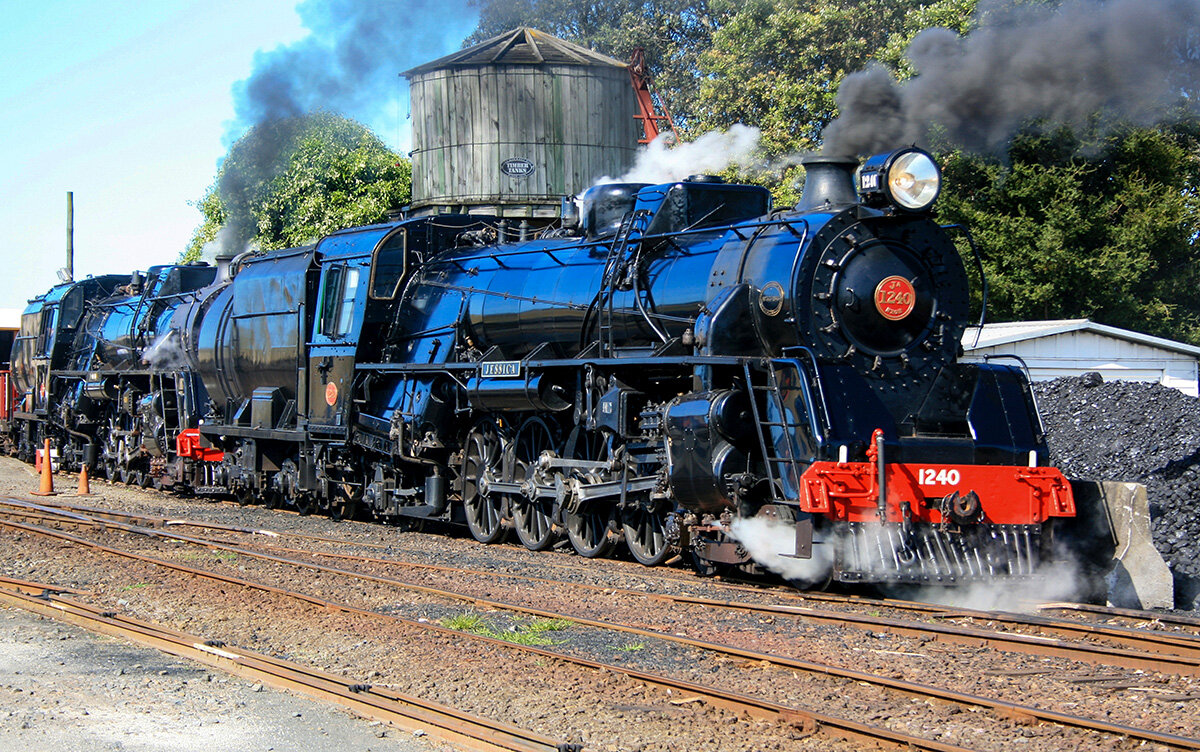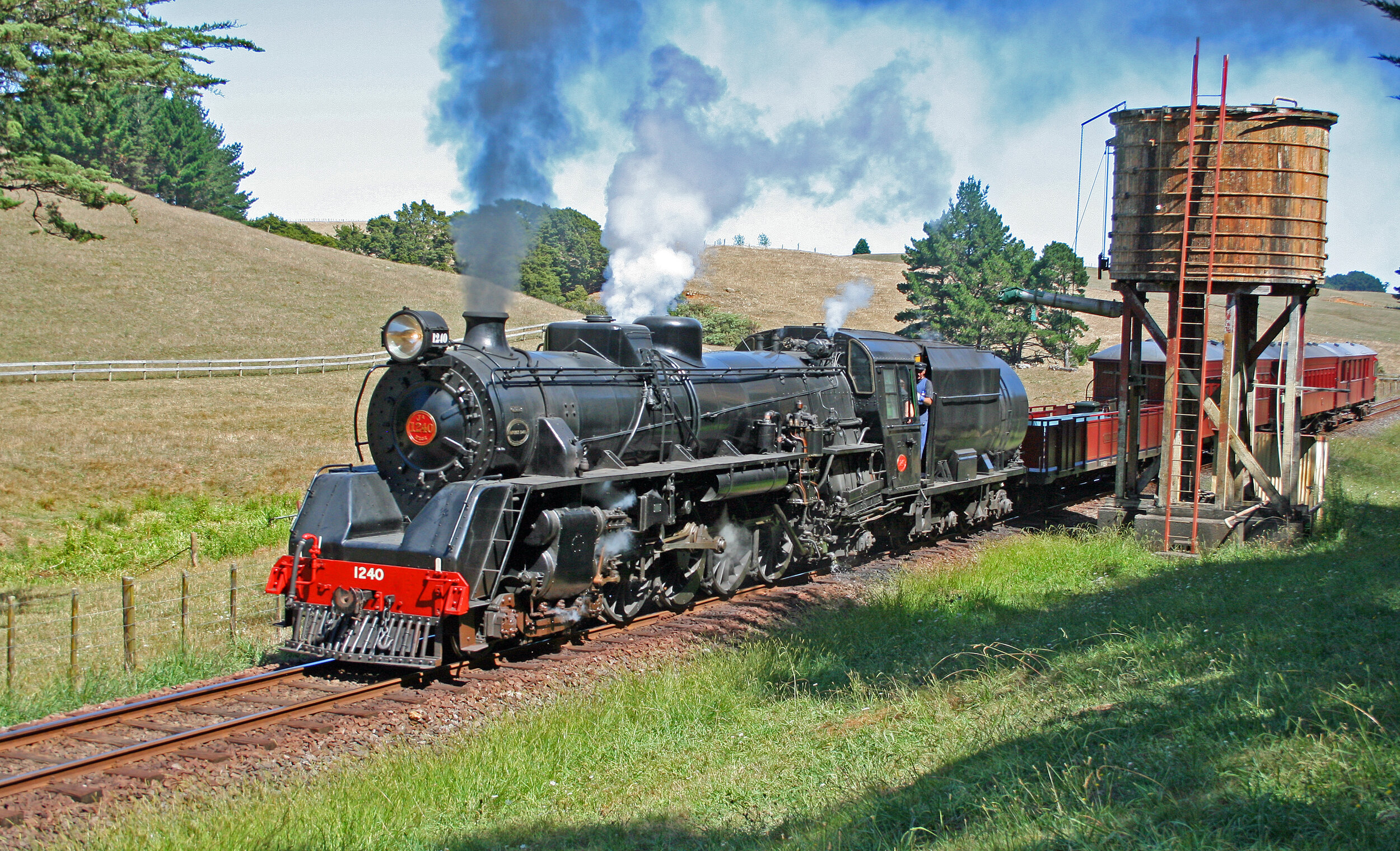Ja1240
Details
Wheel Arrangement: 4-8-2
Manufacturer: North British Locomotive, 1939
Builders Number: 24559
Valve Gear: Baker
Cylinders: 18” dia. / 26” stroke
Weight in working order: 108.9 tons
Driving Wheel Diameter: 54”
Boiler Pressure: 200 psi
Tractive Effort: 24.960 lbf
Overall Length: 66ft 11in
Ja1240 was built at the Hillside workshops in Dunedin in 1947 and entered service in March of that year. It was the first Ja to be built. It was a South Island locomotive and spent its life hauling goods and passenger traffic. Unlike the 'J's, the 'Ja's were built without streamlining. At the outset they were fitted with cross-compound air compressors, and most were equipped with roller bearings on all except one pair of crank pins. These locomotives became the mainstay of South Island operations and were rated to haul 1000 ton freight and 400 ton passenger trains on easy grades. Sixteen North British 'Ja's were built as oil-burners, and 35 built by NZR Hillside 1946-56 with similar data to 'J' class.
Ja1240 was officially withdrawn from service 16th of November 1971 although the last train it hauled was train 190 on the 27th October 1971. Unfortunately the locomotive failed at Rolleston with a broken crankpin bolt.
At this time Peter Coleman, from Blenheim, had purchased a number of parts from Ja1254 and had become a regular at Linwood Depot in Christchurch as he travelled backwards and forwards collecting the parts in his 1951 Austin A40 Devon. Some of the steam enthusiasts at the depot suggested he should purchase a whole locomotive. The Linwood Depot foreman, of the time, Geoff Griffin, suggested Ja1240 which was for sale for $1300. Peter contacted NZR who quoted him $332 to tow 1240 to Blenheim. Prior to the locomotive being towed to Blenheim the broken crankpin bolt was replaced and 1240 was towed to north as part of a goods train in February 1972.
Once the locomotive was at Blenheim, Peter spent a fortnight of long hours disassembling it to move it the 10km’s to his home. Once the locomotive was there it was reassembled and a crane and bulldozer positioned it on the property. When delivered 1240 was in reasonable shape having been into Addington Workshops in 1969 for tyre turning. While there the horn blocks, wedges and compensating gear were all overhauled as well. All the cab fittings and gauges were complete although the number plates were missing. Prior to this trip into the workshops 1240 was overhauled in December 1964 when it got the boiler off Ja1255 and in 1966 it received the driving wheels off J1200. Peter had the cab-side plates re-made and the original smokebox number plate was returned anonymously. The smokebox plate and the cab plates on the locomotive today are all replicas.
In 1991 the locomotive was purchased from Peter’s estate by Ian Welch and taken back to the rail at Blenheim where it was towed north to Mainline Steam’s Parnell depot where it sat in the shed until work could be started in 2006.
It was stripped down to its basic components with many parts being re-built or repaired and it has taken many thousands of hours of labour to bring it back to life and is a credit to all who have worked on it and to Ian Welch for having the drive and enthusiasm to fund its re-build.
A survey of the locomotive, before restoration began, showed it to be in poor condition overall. However, the boiler shell and underframe were sound and all wheels and tyres were serviceable so the decision to begin restoration was made.
Initially it was intended to convert Ja1240 to oil-fired, however, after some debate and consideration the decision was made to keep it as a coal burner.
With a project the size of restoring a steam locomotive to mainline condition there are numerous people involved throughout its course and with the successful completion of this project there are some which must require special mention.
First of all we must mention Peter Coleman who saved the locomotive in the first instance from the scrappers torch. On Peters death Ian Welch had the foresight to step in and purchase Ja1240 to save the locomotive for a second time, removing it from Peter’s property and transporting it to Auckland where it was securely stored.
On commencement of the project Grant Hjorth was the engineering leader deciding on what needed to be done and how best to achieve the desired outcome. This took many hours of planning and checking drawings and sourcing materials. Grant was ably supported by Lindsay Baker on the shop floor. Lindsay did a lot of the actual mechanical work and supervised and assigned jobs to the volunteers. Lastly, but not least, the Mainline Steam volunteers who put in many hours of hard, dirty work to bring Ja1240 back to life and their contribution can not be underestimated.


